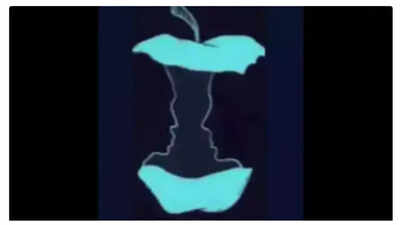Optical illusions continue to captivate audiences, offering a fascinating way to test our observational skills and challenge our brains. These visual puzzles arise when our brains misinterpret the information our eyes send, leading to perceptions that deviate from reality. A seemingly static image might appear to move, or identical shapes might seem to differ in size.

The image above, recently shared by Marina Winberg on social media, presents a classic dual-illusion. At first glance, viewers might perceive either an eaten apple or two faces in profile. According to Winberg, the initial perception reveals an intrinsic aspect of your personality. Take a moment to carefully examine the image and determine what you see first, then read on to discover what it means.
Winberg explains that the image presents "two faces (a man and a woman) looking at each other OR an apple core—what you notice first says a lot about your mindset!”
If You See Two Faces First:
According to Winberg, noticing the two faces first indicates that “You’re a logical, analytical thinker with strong morals. You think before you act, value stability, and solve problems creatively— but sometimes, curiosity gets the best of you!”
If You See an Apple Core First:
Winberg suggests that perceiving the apple core first implies that “You’re intuitive, emotionally aware, and great at reading subtle cues. You know the right thing to say, but often stay quiet. Stability matters to you, and you protect what’s important.”
Generally, there are three primary classifications of optical illusions:
Literal Illusions: These illusions occur when the brain combines various elements of an image to create a perception of something that isn't truly there. A prime example is the dual-image of two faces or a vase, where perception shifts depending on interpretation.
Physiological Illusions: These illusions stem from the overstimulation of the visual system. Factors such as excessive exposure to light, rapid movement, or intense colors can induce effects like afterimages or the illusion of movement.
Cognitive Illusions: These illusions tap into the subconscious processes of the brain. The Müller-Lyer illusion, where lines appear to vary in length due to the surrounding shapes, exemplifies this category.
Newer articles
Older articles
 Raducanu Shuts Down Alcaraz Dating Rumors, Confirms US Open Mixed Doubles Partnership
Raducanu Shuts Down Alcaraz Dating Rumors, Confirms US Open Mixed Doubles Partnership
 Gujarat Cricket Association to Introduce New T20 League in 2025-26 Season
Gujarat Cricket Association to Introduce New T20 League in 2025-26 Season
 Gavaskar Calls for Kuldeep Yadav's Inclusion in Second Test; Questions Bumrah's Fitness
Gavaskar Calls for Kuldeep Yadav's Inclusion in Second Test; Questions Bumrah's Fitness
 Najmul Hossain Resigns as Bangladesh Test Skipper Following Sri Lanka Defeat
Najmul Hossain Resigns as Bangladesh Test Skipper Following Sri Lanka Defeat
 Rishabh Pant is 'Reinventing' Cricket: Greg Chappell Lauds India Star's Game-Changing Impact
Rishabh Pant is 'Reinventing' Cricket: Greg Chappell Lauds India Star's Game-Changing Impact
 Unlock Your Personality: What Your Phone Grip Says About You
Unlock Your Personality: What Your Phone Grip Says About You
 Headline: Vegetarian Power: 20 Plant-Based Protein Sources That Outperform an Egg
Headline: Vegetarian Power: 20 Plant-Based Protein Sources That Outperform an Egg
 NASA's Space Exploration Goes Mainstream: Streaming Service Lands on Netflix This Summer
NASA's Space Exploration Goes Mainstream: Streaming Service Lands on Netflix This Summer
 Wimbledon 2025: Streaming Guide - How to Watch Live in India and US
Wimbledon 2025: Streaming Guide - How to Watch Live in India and US
 Shadman Islam Defends Bangladesh Batting After Day 1 Stumble Against Sri Lanka
Shadman Islam Defends Bangladesh Batting After Day 1 Stumble Against Sri Lanka